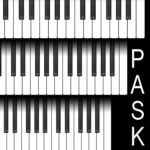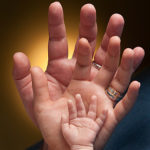Stretching exercises
Pianists and teachers often discuss or promote particular stretching (among many other) exercises for pianists.
It is important to consider the aims of stretching the hands, fingers or arms. There are often two broad, sometimes overlapping, aims: (1) increasing hand or finger span, (2) maintaining muscle flexibility and strength over the longer term – such exercises are often part of a pianist’s regular warm-up routine.
Can stretching the fingers and hands increase a pianist's reach at the keyboard?
Pianists with ‘small hands’ (defined broadly as those who find their hand span constrains their playing and repertoire choice) often turn to the possibility of stretching exercises and even mechanical devices to increase their span – either their overall span between thumb and fifth finger and/or between other digits. Some pianists claim that certain exercises have ‘worked for them’ and recommend them to others. Claims based on one person’s personal experience have no scientific basis. Furthermore, the supposed ‘benefits’ are impossible to assess if the person was still growing during the ‘stretching’ period.
Looking at the anatomy of the hand, the metacarpal heads (knuckles of fingers 2 to 5) are held together with a thick ligament which cannot be ‘stretched’, only sprained or torn. Also, each finger joint has ligaments along each side that should not be over-stretched to avoid the risk of joint damage or instability. Only the muscles between the thumb and index finger in the web space can be stretched of necessary, but with care to avoid straining the ligaments at the base of the thumb joint. Hence, there is limited potential for increasing a pianist’s hand span or finger flexibility by stretching. (B. Ackermann, 2020). The maximum active stretch (thumb to fifth) is a function of (1) finger length, (2) palm width, and (3) angle of abduction. If a pianist has an angle of abduction close to 180 degrees then there is no capacity to widen the hand span any further.
During the 19th century, hand surgery aimed at widening pianists’ hand spans became popular.
Hand surgery reached the height of its popularity late in the 19th century, when it was used for everything from speeding up parlor pianists’ learning of salon music to enabling professionals to widen their span and raise the tighter ring finger another inch or so off the keys…..An operation for severing those lateral tendons was developed in the mid-19th century by a surgeon named William E. Forbes….It was a controversial operation, but Dr. Forbes estimated that by 1898 he had performed it 2,500 times…. Czerny exercises for pianists took too long to master. Machines to stretch and isolate the fingers were developed. But the operation only took 15 minutes.’ (New York Times, 14 June 1981).
Even today, in some countries, there are anecdotal reports of talented young pianists, mostly female, being encouraged to have this type of surgery.
Many exercises published and promoted by teachers during the 20th century were deliberately designed to stretch the fingers apart. Deahl and Wristen (2017) state that stretching the hand by means of devices and exercises of this type is especially problematic is due to the anatomical design of the hand. These limitations are compounded when the hand is fully open to its limit, a known injury risk factor for small-handed pianists. They conclude: ‘Despite anecdotal accounts of individuals who express confidence in the value of stretching exercises or devices, there is no empirical evidence that these exercises or devices can physically extend the reach of the hand. In fact, routines or mechanical appliances of this kind have been implicated in a number of devastating injuries, most famously the case of Robert Schumann. They ought to be viewed with extreme caution and are perhaps best avoided entirely.’ (p 18).
In addition to Deahl & Wristen (2017), other authors including Wagner (1984), Ortmann (1929) and Kloeppel (2000) have found no evidence, nor scientific basis to support the contention that hand spans increase significantly over time due to playing a musical instrument and/or stretching exercises. Essentially, joint mobility is genetic and cannot be trained (Prenger, 2013).
Although Driscoll & Ackermann (2012) suggested that the significantly greater left hand thumb to fifth finger spans among lower string players would most likely result from the stretching of ligaments, muscles and tendons from many years of playing those instruments, the magnitude of the average difference (0.2 inches) is relatively small. The string players in that study, being elite orchestral musicians, would have most likely started learning their instrument in early childhood, when some minor effect of the activity on finger spans may have been possible.
There is some evidence that pianists have slightly larger hand spans than non-pianists. (Boyle, Boyle & Booker 2015). The two main possible reasons could be: (1) the long term effect of playing the instrument and/or stretching exercises going back to childhood, and (2) those with larger hands finding the task relatively easier and achieving greater success than those with smaller hands, and hence being more likely to continue playing (i.e. self-selection).
It is certainly plausible that those with ‘small hands’ are more likely to give up playing the piano at a relatively early age, while those with favourable hand spans find piano playing comfortable and enjoyable, are more likely to achieve some success and are therefore more encouraged to continue. This pattern of self-selection is evident in many sports. Part of this pattern is likely to be teachers and parents encouraging children, especially girls, to focus on other instruments that better suit their hands.
Stretching as part of a warm-up routine
Many experts recommend a warm-up away from the piano, including the trunk and arms to optimise the whole arm when playing. The hands and fingers can also benefit from gentle stretching and moving the fingers apart and together. Fingers should definitely not be forced apart. For small-handed pianists in particular, integrating whole-arm action with finger muscle action is very important.
Here are some examples of exercise routines recommended by experts:
- Warm-up exercises developed by Dr Alice Brandfonbrener and Carol Brooks (reproduced in Berenson et al, 2002. https://paskpiano.org/wp-content/uploads/2021/09/Warm-Up-Exercises-Brandfonbrener.pdf
- From piano teacher Brendan Hogan: https://www.youtube.com/watch?v=e28xk4YnUAA&fbclid=IwAR3O7-8_7BdLFrextyqqf_2JDbkKUCrz4rYbBT5-j7BhtVlRVfY5Qcjykew
- From pianist and doctor, Czeslaw Sielzycki: https://www.youtube.com/watch?v=bTptqn9U6fU&fbclid=IwAR3UnqUx-LTVsOhZIsqR0igD7m_dEgp0OrhuL-Y5o4K59R8MWqCKmwAWEuI
- From Anderson Dart and Nick Gallo, Physical Therapy 101: https://www.youtube.com/watch?v=_jWxIPrBSdQ&fbclid=IwAR37aH62vfQmtWABBFPTtI94EkDuVGMdNWeDf-nU-K_1t5dDI8CE0lZWjj4
Of course, any pianist experiencing pain or injury related to piano playing should consult an expert.
Further research is needed, particularly relating to the benefits or dangers of stretching routines for young players. Older pianists need to maintain healthy warm-up and exercise routines in order to maintain muscle strength and flexibility for as long as possible. See also: Impacts of aging
References
Ackermann, B.1 (2020). Personal Communication.
Berenson G. et al (2002). A Symposium for Pianists and Teachers: Strategies to Develop the Mind and Body for Optimal Performance. Heritage Music Press, Dayton OH, pp 219-220.
Boyle, Boyle & Booker (2015). Pianist hand spans: Gender and ethnic differences and implications for piano playing. Proceedings of the 12th Australasian Piano Pedagogy Conference, Beyond the Black and White, Melbourne, July 2015. https://appca.com.au/proceedings/proceedings.html
Deah, L. & Wristen, B. (2017). Adaptive Strategies for Small-Handed Pianists. Oxford University Press, UK.
Driscoll, T. & Ackermann, B. (2012). Applied musculoskeletal assessment: Results from a standardised physical assessment in a national population of professional orchestral musicians. Rheumatology: Current Research, vol. S2, 1-7. http://omicsonline.org/applied-musculoskeletal-assessment-results-from-astandardised-physical-assessment-2161-1149.S2-005.pdf.
Kloeppel, R. (2000). Do the “spreadability” and finger length of cellists and guitarists change due to practice? Medical Problems of Performing Artists, 15 (1), 23-30.
Ortmann, O. (1929). The Physiological Mechanics of Piano Technique. Kegan Paul, Trench, Trubner & Co., Ltd., London, and E.P. Dutton & Co., Inc., New York.
Prenger, M. (2013). Hand en piano. Handreikingen voor de lespraktijk. EPTA Nederland. https://eptanederland.nl/piano-bulletin/90-2013-3/
Wagner, C.H. (1984). Success and failure in musical performance: Biomechanics of the hand. In Roehmann F.L., & Wilson F.R. (Eds): The Biology of Music Making, Proceedings of the 1984 Denver Conference, St Louis, Missouri, MMB Music Inc.,1988, 154-179.
https://www.nytimes.com/1981/06/14/arts/when-a-pianist-s-fingers-fail-to-obey.html
- Dr Bronwen Ackermann is Associate Professor in the Faculty of Medicine and Health at the University of Sydney. She is a specialist musicians’ physiotherapist, musculoskeletal anatomist and musicians’ health researcher and past Chief Editor of the international journal, Medical Problems of Performing Artists., M.


